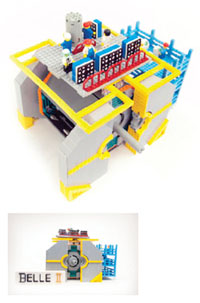Lego Belle II
 |
| 10,000 Lego blocks were used to make a replica of the Belle II detector. Legos called Electric Light Unit Power Functions and clear blue blocks simulate collisions inside the detector. Photos courtesy of KEK |
Particle detectors help physicists study the fundamental building blocks of matter. Now building blocks can help people study detectors.
In Japan, Yuji Katagiri has built a Lego scale model of the inner workings of the Belle II detector, including glowing particle collision tracks.
Belle II is an experiment currently under construction at Japan's high energy accelerator research laboratory KEK. The scientists who are collaborating on the experiment and KEK's public relations office contacted Katagiri, head of the University of Tokyo's Lego club, with a request to build the model as a public outreach tool.
“I tried to make this model as real as possible so that scientists who are actually involved in the Belle II project would be satisfied by my work,” Katagiri says. “I was a bit anxious because I did not specialize in physics study, but it was really fun making it.”
It took 10,000 common Lego blocks and a month and a half to build the model. Katagiri, whose first love is chemistry, has also built Lego representations of carbon nanotube molecules and graphene.
“I think Lego is a great tool for science communication, since it works not only for kids but for people not really interested in science,” Katagiri says. “Some of my Lego friends got interested in science through my other work when I presented it at a school festival.”
KEK will eventually display the Lego Belle II model at the laboratory.
Cynthia Horwitz
Click here to download the pdf version of this article.






